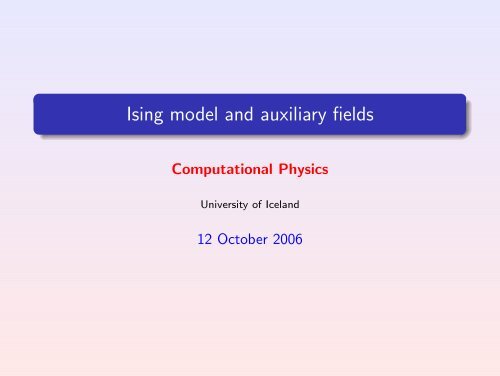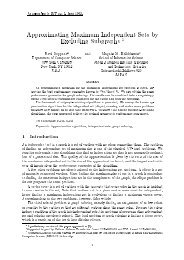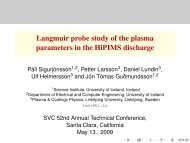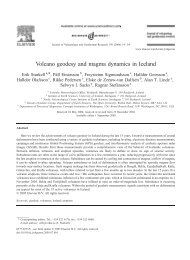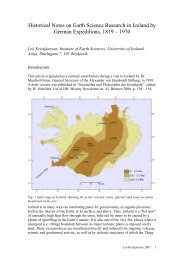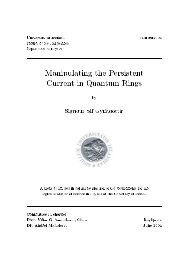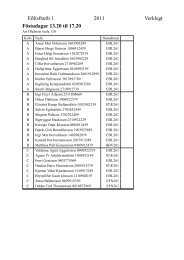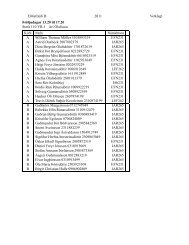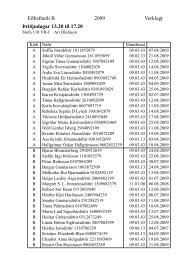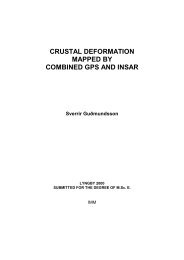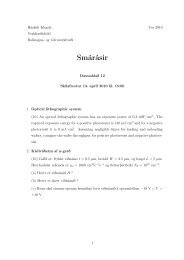You also want an ePaper? Increase the reach of your titles
YUMPU automatically turns print PDFs into web optimized ePapers that Google loves.
Lattice systems IAt each site x n = an we haveH(φ) = tφ n−1 + µBφ n + tφ n+1Introducing normal coordinates (periodic: x N+1 = x 1 )φ n = √ 1 ∑e iqan φ(q)NThis diagonalizes the HamiltonianHφ(q) =q≡ǫ(q){ }} {(2t cos(qa) + µB)φ(q)⎛⎜⎝On matrix form:⎞µB t 0 0 ...⎛t µB t 0 ...0 t µB t ... ⎟⎠ → ⎜⎝.... ..ǫ(q 1 ) 00 ǫ(q 2 ) 00 0 ǫ(q 3 ) 00 0 0 ǫ(q 3 )⎞⎟⎠
Lattice systems IISame applies in two dimensionsNormal coordinatesφ n,m = 1 √N∑The “eigenenergies”q x,q ye ia(qxn+qym) φ(q x ,q y )Hφ(q) = ( 2t(cos(q x a) + cos(q y a)) + µB ) φ(q)Note that the dispersion is not parabolic⇒ Free particle at qa ≪ 1
1D <strong>Ising</strong> <strong>model</strong>We first consider the 1D <strong>Ising</strong> as an “exercise” (no phase transition )The HamiltonianH = −N∑( J2 (S m−1 + S m+1 )S m + µBS m ))m=1Two methods possible1 Introduce “spin-wave” variables (Fourier transformation)2 Introduce a gaussian integration <strong>auxiliary</strong> fieldWe choose nr. 2: Multidimensional Gaussian integrationWe write the partition function asZ(β) ==∑e β P Nm=1( J 2 (S m−1+S m+1 )S m+µBS m))S 1 ,...,S N∑S 1 ,...,S Ne P m,n SmJm,nSn+H P n Sn
Gaussian integration IHow do we h<strong>and</strong>le I = e P m,n SmJm,nSn ?J is a symmetic matrix: J = U † diag(J )UI= e P m SmJm,mSm= ∏ ∫ dφm√ e − P (φm−Sm √ 2Jmm) 2m+ P 2 m SmJm,mSmm 2π= ∏ m«∫ P √dφm m„− φ2 m2 +φ m 2Jm,mSm √2πIntroduce a change of variables˜ φ m = √ 2J m,m φ m
Gaussian integration IIIn the new integration variablesI= ∏ m„∫ √Jmm d√ ˜φPm − ˜m2πφmJmm −1«φm ˜ √+ φ˜2 m 2Sm= det(J) ∏ m∫ dφm√2πe − P m,nφmJ −1 mn φn2 + √ 2 P m φmSmHere we used:1 det(U) = 12 ˜φT J −1 ˜φ = φ T J −1 φ3 ˜φT · S = φ · SWe are left with linear in S m terms⇒ trace out S m = ±1
1D <strong>Ising</strong> <strong>model</strong>The “new” partition function:Z(β) =∑S 1 ,...,S Ndet(J) ∏ m= det(J) ∏ m∫ dφm√2πe − P m,n∫ dφm√2πe − P m,nφmJ −1 mn φn2 + P m (√ 2φ m+H)S mφmJ −1 mn φn2 + P m ln(2 cosh(√ 2φ m+H))This is an EXACT resultHow can we proceed?Remember that the sum is over position∑f m ≈ 1 ∫dxf (x)amHow do we h<strong>and</strong>le J −1mn(inverse coupling of neighbours)?
1D <strong>Ising</strong> <strong>model</strong>Normal mode dispersion1J(q)=βJ1( ) ≈ 1 ) (1 + a21 − (qa)22+ ... βJ 2 q2 + h.o.t.Remember that F −1 (q 2 ) = − d2dx 2Exp<strong>and</strong>ing the ln(cosh(φ)) = 1 2 φ2 − 1 12 φ4Z= N ∏ m∫≡∫ dψm√2πe β R dx( 1 2 ψ(x)(∇2 ψ(x))−˜r 0 ψ 2 (x)−ũ 0 ψ 4 (x))Dψe −β R “dx 12 (∇ψ(x))2 +˜r 02 ψ 2 (x)+ ũ04 ψ (x)”4All constants a,J,β,... are absorbed in ψ,˜r 0 ,ũ 0Solving this beast :Stationary phase approximationIn field theory called saddle point approx.
L<strong>and</strong>au Theory IRemember that :e −βG = ZLev L<strong>and</strong>au’s hypothesis:For the ordered phase an order parameter φ can be definedT ≤ T C : φ is small quantityExp<strong>and</strong> the thermodynamic potential (energy) in φG(T, P, φ) = G 1 (T, P)φ+G 2 (T, P)φ 2 +G 3 (T, P)φ 3 +G 4 (T, P)φ 4 +h.o.t.= G 2 (T, P)φ 2 + G 4 (T, P)φ 4 (symmetry !!)
L<strong>and</strong>au Theory IIThe critical behavior is determined by G 2 (T,P)By definition we haveG 2 (T,P) = 0,if T = T cAgain, we exp<strong>and</strong> ...G 2 (T,P) = g 2 (P)(T − T c ) + h.o.t.,<strong>and</strong> put G 4 (T,P) ≈ G(T c ,P) = g 4 (P)L<strong>and</strong>au function with “magnetic field” HG(T,P,φ) = g 2 (P)(T − T c )φ 2 + g 4 (P)φ 4 + HφThe phase is determined by the minimum conditiondGdφ = 0
Field theory primer: Saddle point approximationThe complete version of the stationary phaseSaddle point approximationThe partition function∫Z = Dψe −βS(ψ(x),∇ψ) ≈ e −βS(ψ 0)ψ 0 (r): Saddle point approximationDetermined by the Euler-Lagrange equationdLdψ − d dLdx d(∂ x ψ(x)) = 0The saddle point solution (classical solution)− d2 ψ(x)dx 2 + ˜r 0 ψ(x) + ũ 0 (ψ 2 (x))ψ(x) = 0Extension to d-dimension is just the same−∇ 2 ψ(r) + r 0 ψ(r) + u 0 ψ(r) 3 = 0
Ginzberg-L<strong>and</strong>au functionalLets consider a superconductor:The amount particles in the superconducting stateOrder parameter n(r) = |Ψ(r)|The equation describing the order parameter12m ∗(−i∇ − eA)2 Ψ(r) + α 1 Ψ(r) + α 2 |Ψ(r)| 2 Ψ(r) = 0Gauge invariant formCan be derived from the microscopicBardeen-Cooper-Schrieffer theoryUseful to study macroscopic effects (Meissner effect)
Gross-PitaevskiiA cloud of bosons form a condensate:Bose-Einstein condensationWhat are the effects of1 External potentials (“all “of potential)2 Interation of particlesThis is included in the Gross-Pitaevskii equationCloud of trapped bosons (trapping potential V trap )Bose-Einstein condensationThe order parameter equation n(r) = |Ψ(r)| 2(− 22m ∇2 + V trap (r) + 4π2 am |Ψ(r)|2 )Ψ(r) = µΨ(r)The strength of the particle interactions a :scattering length
FluctuationsGoing beyond the saddle pointS(Ψ) = S(ψ 0 ) + ∂2 S∂ψ2δψδψ + h.o.t.Higher order terms do NOT have to vanish in thethermodynamic limitGive corrections to critical exponentsm ∝ |T − T c | βSaddle point gave β = 1/2 (exact β = 1/8)This story is beyond our scope . ..
SummaryLecture I:We transformed the infinite range <strong>Ising</strong> <strong>model</strong> into a GaussianintegralWe discussed the stationary phase approximation for theinfinite range <strong>Ising</strong> <strong>model</strong>Lecture I:Gives same result as the mean fieldSt<strong>and</strong>ard <strong>Ising</strong> <strong>model</strong> in d dimension using Gaussian integralsAuxiliary <strong>fields</strong>Saddle point approximation/Field theoryFluctuations


